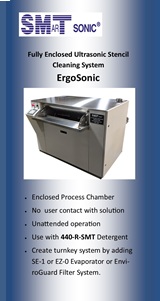|

|
|
| Ask the Experts | |||||||
|
|||||||
|
October 21, 2024 - Updated April 24, 2013 - Originally Posted Jumper Wire GaugeIs there a recommended gauge and insulation type for standard circuit board jumper wires? Is there a suggested insulation color? Can you point me to any specifications or standards. G.S. |
|||||||
| Expert Panel Responses | |||||||
|
Jumper wires on circuit boards can take a couple of forms. If you must use through hole, bent solid wire jumpers are the only practical choice and most likely added by hand. If you can change to an SMT layout for the jumpers, you can use zero Ohm resistors which have the advantage in that you can place them by machine like any SMT resistor. In both cases, the current these jumpers must carry will determine the gauge or package size (higher current means larger gauge or SMT package size). Refer to wire gaga ampacity charts to select the wire gauge or the zero Ohm resistor's manufacture's data to make sure you have the needed size to carry the expected current. If the current they carry is low (mA), then the only reason to select a larger gauge is to make it easy to place or easy to read the value, so you know that the SMT part that looks like a resistor is really a jumper (0 Ohms),or otherwise make it easier to handle during the assembly process. I know of no insulation color standards for jumpers, however, most jumper wires use a Teflon based insulation (PFA) which will not melt at solder temperatures. Teflon insulation is naturally white, making it the most common color and is likely the lowest cost. Although Teflon based insulations can be found in other colors, unless there is some desired color for athletics reasons, white is the most common.
Senior Project Engineer Electronic Controls Design Inc Paul been with Electronic Controls Design Inc. (ECD) in Milwaukie, Oregon for over 39 years as a Senior Project Engineer. He has seen and worked with the electronic manufacturing industry from many points of view, including: technician, engineer, manufacture, and customer. His focus has been the design and application of measurement tools used to improve manufacturing thermal processes and well as moisture sensitive component storage solutions.
According to IPC-7721, Section on Jumper Wires, section 6.1, in the Jumper Wire Selection section #5 states: "Recommended wire is solid, insulated, plated copper wire, 22 to 32 AWG with a heat resistant insulation. Wire with tin-lead plating may be restricted due to environmental laws." As for the color, that is up to you, but keep it simple from the perspective the function of the particular wires. For example ECO wires to the board, could be green, whereas jumper wires due to etch defects could be red, and so on, so by looking at the board, one could distinguish between the functions of the wires. Therefore the sections from IPC-7711/7721 is section 6.1 and from IPC-A-610 it is section 7.5.4.1 on page 7-72.
Vice President, Technical Director EPTAC Corporation At EPTAC Corporation, Mr. Lambert oversees content of course offerings, IPC Certification programs and provides customers with expert consultation in electronics manufacturing, including RoHS/WEEE and lead free issues. Leo is also the IPC General Chairman for the Assembly/Joining Process Committee.
Good answer, Leo. I would also like to point out two things. The IPC 7711/7721 standard also provides a chart to show you the wire gauge that will provide the same current-carrying capacity as the old trace, based on the original trace width. Also, use of Teflon-insulated wires as jumper wires may not be a good idea due to the Teflon's inclination to cold-flow away from any pressure point. So if it is pushed or routed against any exposed metal lead or other conductor, it can flow away, allowing an electrical short. Many high-rel companies use magnet wire and coat over the varnish with a good epoxy as the final step. This is a very reliable method.
Advanced Engineer/Scientist General Dynamics Richard D. Stadem is an advanced engineer/scientist for General Dynamics and is also a consulting engineer for other companies. He has 38 years of engineering experience having worked for Honeywell, ADC, Pemstar (now Benchmark), Analog Technologies, and General Dynamics.
|
|||||||
| Submit A Comment | |||||||
|
Comments are reviewed prior to posting. You must include your full name to have your comments posted. We will not post your email address. |
|
Free Newsletter Subscription
Circuitnet is built for professionals who bear the responsibility of looking ahead, imagining the future, and preparing for it. Insert Your Email Address |
|

|




